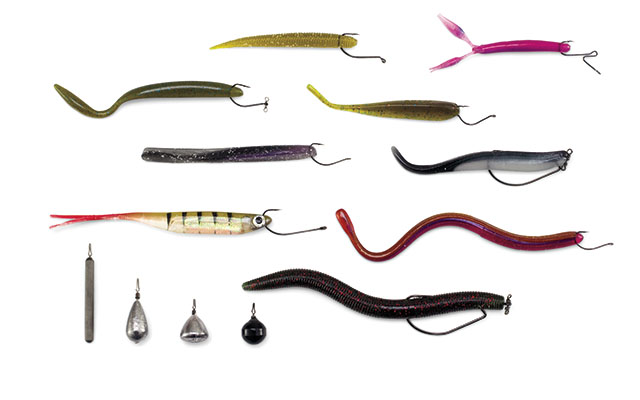
Drop-shotting has come of age, no longer a niche finesse fad, but a mainstream tactic as critical as crankbait mastery or flippin’ in many situations. Even dedicated power fishermen acknowledge the facts and always have a spinning rod or two on board. And they work to improve their techniques, knowing they’re mincemeat without it.
Seth Feider of Bloomington, Minnesota, is one of those pros, and he could easily teach a class on smallmouth specifics. Technical drop-shot skills placed him in the winner’s seat at the 2016 Bassmaster Angler of the Year Championship on Mille Lacs in Minnesota last September. He paced the field with a three-day total exceeding 76 pounds—over a 5-pound average. His was the heaviest smallmouth catch ever weighed in at a Bassmaster event. He finished 6.5 pounds ahead of second-place finisher Brent Ehler, who also used drop-shot techniques to catch over 90 percent of his smallmouths.
Our Japanese-technique guru and historian, David Swendseid, says the tournament world first took notice of the technique in the 1990s. “Drop-shotting has two names in Japan,” he says. “It’s called the Tsunekichi rig or Daun Shotto (meaning down shot). At its inception, the drop-shot rig was introduced as an ultralight technique. Early adherents employed 4- or 5- pound line and nothing heavier than 3/16-ounce teardrop weights on light tackle. Once American anglers began using it, they often employed slightly heavier lines, weights, and rods.”
While most bass pros use 7- to 10-pound line to drop-shot for largemouths, many experts mostly use 6-pound fluorocarbon for smallies. Swendseid said the best drop-shotter today is probably Aaron Martens, the 2015 Bassmaster Elite Series Angler of the Year. “With his multiple drop-shotting wins around the country, Martens demonstrates his versatility with the technique,” Swendseid says. “I use it because it’s so crazy effective. If I had my choice I’d fish other ways, though.”
So would a lot of pros. It was interesting, though, to watch almost an entire field of Bassmaster Elite anglers using spinning gear. Feider is at home with spinning tackle and Minnesota smallmouths. He used a 7-foot, medium-light Daiwa Steez AGS rod and a Daiwa Exist 3012 spinning reel spooled with 10-pound Sufix 832. He tied in a 15-foot leader of 6-pound Sufix Fluorocarbon, with a #2 VMC Neko Hook and an 18-inch to 2-foot dropper terminating in a VMC TDSC Tungsten Drop-Shot Cylinder Weight. Every detail influences the outcome.
Tech Specs
A precise combination of rod, reel, line, hook, sinker, and sonar seems more integral to the success of drop-shot angling than any other technique in bass fishing. “The rod tip must bend easily,” Feider says. “It’s important that bass pick up the bait without feeling any tension. The tip has to be fast but very light and flexible, giving to the least amount of pressure. That’s the key to proper action on a drop-shot. The hook is critical, too. The longer shank on the VMC Neko sticks in the roof of its mouth, so landing percentage is second to none. The #2 is light, so they take it all the way in, but the gap is big enough to stick and stay wherever it ends up.”

Martens uses 6- and 7-pound Sunline Sniper Fluorocarbon with a #1 Gamakatsu Drop-Shot hook. But some anglers are turning to hooks with built-in swivels, like the VMC SpinShot. “The advantages of those hooks are less line twist and the ability to have the hooks stand straight out,” Swendseid says. “I think its benefits increase with the size of the lure. I often use offset-shank hooks, which allow me to tuck the point in the body. The hook shank acts like the keel of a boat to keep the lure upright when I shake the rod tip. Texposing allows you to fish in brush or vegetation.”
One exciting new hook is the Trapper Tackle Drop-Shot Bait Lock. The bend of the hook is “notched” to lock a nose-hooked plastic in place after a “swing and a miss,” or for those times when smallmouths play with the bait without getting hooked. Another unique hook is the Blakemore StandOut, which has an R-bend where the knot’s tied, leading to an eye on an extended shank. The tag end passes through the eye, creating a stabilizer that keeps the hook extended horizontally. Bass can’t knock it out of kilter.
Feider uses long, cylindrical VMC Drop-Shot weights about 90 percent of the time. “They snag less and have a faster fall rate,” he says. “The only time I use round sinkers is for bed fishing. I can put more tension on them without moving the sinker when pitching the rig shallow. I always use 1/2-ounce weights to keep the lure right where I want it. A 1/8- or 1/4-ounce sinker moves. When anglers shake a worm they move the weight. You want to impart action without moving the sinker. That’s what makes a drop-shot what it is—maintaining lure placement precisely on a key spot.”
Martens and Swendseid disagree somewhat, saying there’s a time and place for light sinkers. “I agree with Seth—use a heavy sinker for the purpose of not moving the lure,” Swendseid says. “That’s when you want to keep a lure in their face for an aggravation bite. Martens and Kota Kiriyama are advocates of this technique, but there are other approaches.
“To make a lure move and swim, use the lightest weight possible,” he says. “When I don’t want to swim my lure through open water I do exactly what Seth…





